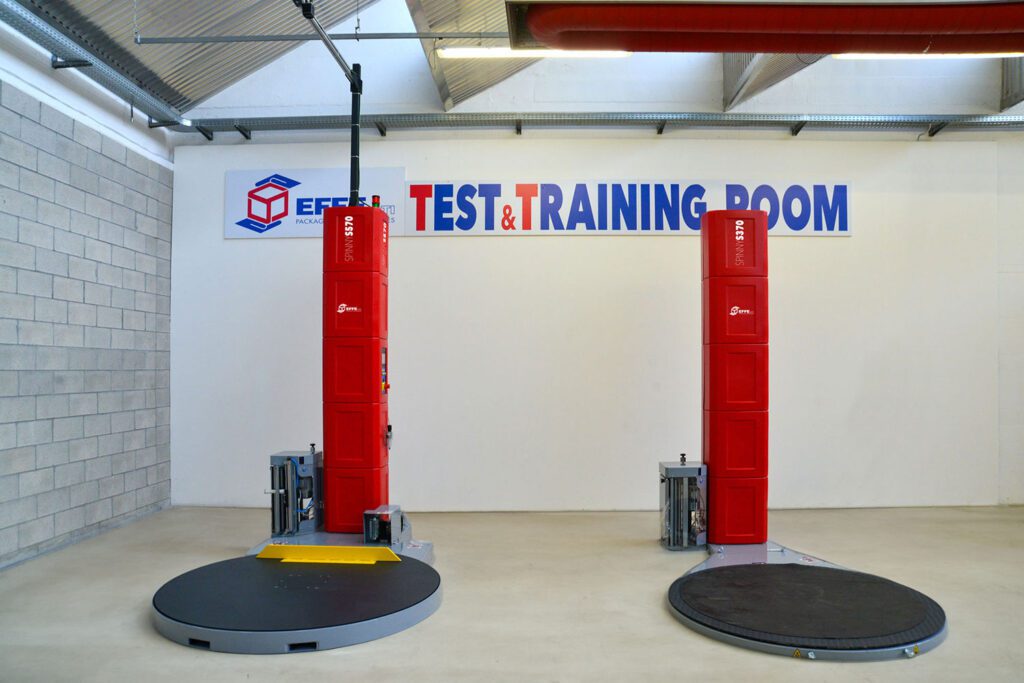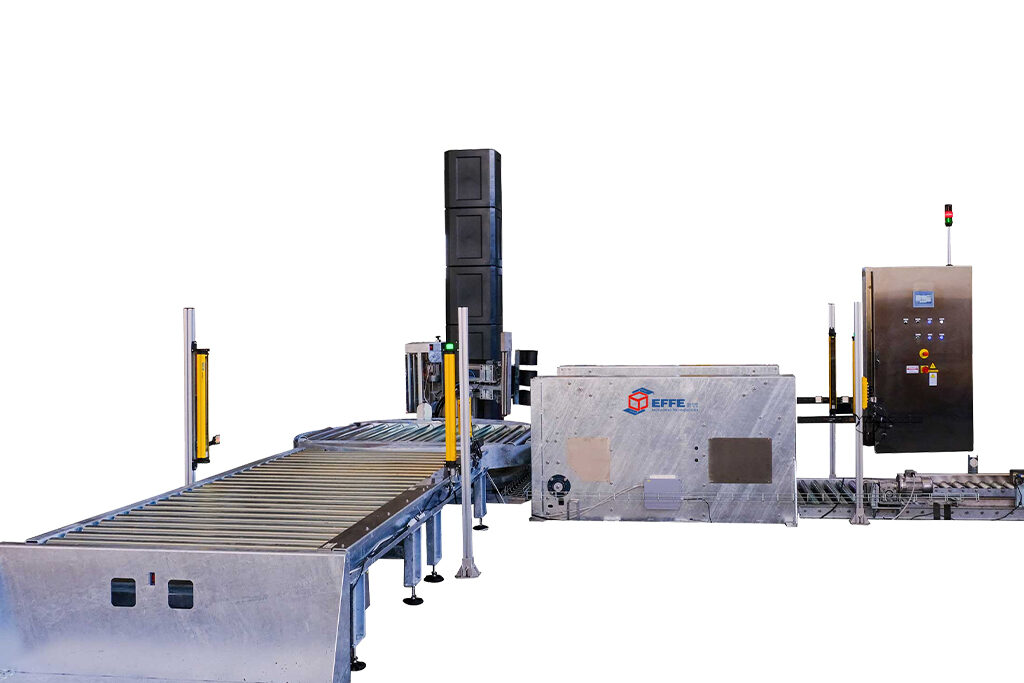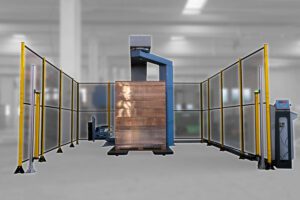A wrapping machine can make a huge difference for your business. Especially in the logistics and industrial packaging sectors, avoiding manual work means not only saving time, but also saving on materials, having a qualitatively better result and also being able to evolve the daily internal organization.
It is clear that choosing the right wrapping machine is a decisive step, because it is an investment that directly affects the reliability of the shipment and the organization of the end of the line.
Wrapping machines can be divided mainly into two categories: automatic and semi-automatic. Understanding the differences between these two approaches is the basis for identifying the most suitable solution for your production context. Effe3Ti has been designing and manufacturing wrapping machines for over 25 years, exporting them all over the world: this is why it knows them very well.
How a wrapping machine works
A wrapping machine is a machine that applies stretch film around pallets or loads intended for transport and storageIts main purpose, therefore, is to stabilize the goods, protect them from dust, humidity or shocks and ensure that they arrive intact at their destination.
Wrapping pallets correctly is not just a matter of aesthetics or order: it means saving time, reducing damage, improving safety and optimizing the use of materials.
With an automated or semi-automated system, the inefficiencies of manual wrapping, which is often tiring, imprecise and prone to errors, are eliminated. In addition to allowing operators to work on other less repetitive activities that have greater value for the company.
Semi-automatic wrapping machine: flexibility and control
The semi-automatic wrapping machine is the most popular solution for all those companies that record medium-low production volumes or have limited operating spaces. In this type of machine, the operator positions the pallet and starts the wrapping cycle: until the operation is completed, then removes the wrapped pallet using a pallet truck or forklift.
This choice is ideal for those companies that want to maintain direct control over the process, optimize initial costs and work with variable batches or frequent format changes. Furthermore, given that it is very simple to use, the semi-automatic wrapping machine requires minimal training and can also be used in contexts where personnel work on multiple tasks at the same time.
Automatic Wrapping Machine: Uninterrupted Productivity
The automatic wrapping machine, on the other hand, is designed for high-volume industrial contexts, where speed and operational continuity are essential. In this case, the entire process – from pallet positioning to film application and cutting – is completely automated.
It is the ideal solution for continuous production lines, to reduce cycle times and to be integrated with conveyor belts and robotic systems. Since the entire operation is automated, an automatic wrapping machine guarantees a high standardization of packaging and a significant reduction in human intervention, with advantages in terms of safety and reliability.
How to choose the right wrapping machine for your business
Every production context has specific characteristics: rhythms, volumes, spaces and level of automation are elements that directly affect the choice of the most suitable machine. Carefully considering some key criteria is essential to identify the most efficient wrapping machine for specific operational needs.
Production volume
If your company handles a large number of pallets to wrap on a daily basis, an automatic wrapping machine can offer greater efficiency and speed. For smaller volumes, a semi-automatic may be sufficient.
Operational flexibility
For productions with variable formats or small batches, a semi-automatic wrapping machine allows greater adaptability and manual control. In contexts with standardized processes, automatic guarantees uniformity and reduction of errors.
Available budget
The initial investment for an automatic wrapping machine is generally higher than for a semi-automatic one. In the long run, however, automation can lead to significant savings in terms of labor and materials.
Integration with the production line
If the production line is already automated or is planned to be automated, an automatic wrapping machine can be easily integrated, improving the workflow. In less automated environments, a semi-automatic one can be implemented with fewer modifications.
Effe3Ti wrapping machines, semi-automatic and automatic
The Effe3Ti catalogue offers excellent solutions for both semi-automatic and automatic wrapping machines.
Among the semi-automatic solutions, the one that stands out is the Spinny S350. It is an extremely versatile and robust machine:
- It is designed for wrapping pallets up to 1200 mm x 800 mm;
- has a load capacity of up to 1,200 kg;
- and is available in various rotary table configurations, from 1500 to 2200 mm, and heights up to 3100 mm.
Furthermore, the motorized pre-stretch system ensures film stretching up to 300% (and up to 400% in the dual motor version), which allows for significant savings on materials.
Another example is the Spinny S570 Datalogger. In addition to its advanced mechanical features, it offers cloud connectivity, remote control, real-time data collection, and consumption and productivity monitoring functions. It is perfect for those who want to integrate the machine into an Industry 4.0 system, track performance, predictively plan maintenance, and control the machine remotely.

On the automatic wrapping machines side, Effe3Ti offers the Rotax S5300, a rotating arm machine designed to integrate perfectly into fully automated lines:
- it is equipped with a motorized pre-stretching system up to 300%, also available in the dual motor version up to 400%;
- The standard model is suitable for wrapping pallets up to 1200 x 1200 mm, with a photocell-detected height of up to 2,100 mm (and optionally up to 3,000 mm).
The automatic film clamping and cutting system, the touch-screen panel – through which to control the speed of the arm, the trolley and the transport systems – and the electronic regulation of the film tension allow for the optimisation of each phase of the cycle.
Another automatic option is the Spinny S2300. It is a compact, high-performance and highly customizable machine, ideal for production contexts characterized by continuous and standardized flows.
The standard model:
- allows the wrapping of pallets up to 1200 x 1200 mm, with a load capacity of up to 2,000 kg;
- the rotary table has an adjustable speed from 5 to 15 rpm via inverter;
- while the height of the load is automatically detected by a photocell.
Furthermore, the motorized pre-stretch system allows the film to be stretched up to 300%, with the possibility of reaching up to 400% in the dual motor version, to reduce material consumption and optimize costs.
The Spinny S2300 is also equipped with a clamp, automatic film cutting and welding, a touch-screen control panel, and safety systems such as the anti-fall protection of the reel trolley.

Wrapping machine for your business: which one to choose?
The choice between an automatic wrapping machine and a semi-automatic wrapping machine does not depend only on a question of budget, but on the desire to optimize the entire packaging process.
The ultimate goal is:
- reduce waste;
- improve load safety;
- achieve both economic and time savings;
- make the work of operators safer;
- better protect products.
Every company has different needs: those looking for flexibility and control can take full advantage of a semi-automatic solution, while those working on large volumes or integrated lines will find an automatic wrapping machine to be a strategic ally for speed, standardization and operational savings. The wrapping machines proposed by Effe3Ti cover both needs, with solid, customizable and efficiency-oriented solutions.
Choosing the right wrapping machine today means investing in safety, order and competitiveness for tomorrow.



